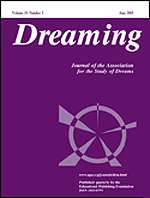Dreaming
Journal of the Association for the Study of Dreams
Dreaming is a peer-reviewed multidisciplinary journal devoted specifically to dreaming.
The journal publishes scholarly articles related to dreams from any discipline and viewpoint. This includes biological aspects of dreaming and sleep/dream laboratory research; psychological articles of any kind related to dreaming; clinical work on dreams regardless of theoretical perspective (Freudian, Jungian, existential, eclectic, etc.); anthropological, sociological, and philosophical articles related to dreaming; and articles about dreaming from any of the arts and humanities.
The journal Dreaming has a 2011 impact factor of 0.841, ranking it 68th out of 125 journals in the category “Psychology, Multidisciplinary”
- Editorial Staff / Contact the Editor
- APA Publisher
- Manuscript Submission Guidelines
- Pricing and Subscription Information [for non-IASD members]
- Pricing for individual articles in Dreaming journal [APA PsychArticlest]
- List of Issues / Abstracts
- Online Articles
DREAMING – IASD’S SCHOLARLY AND MULTIDISCIPLINARY JOURNAL

Because of its large and diverse membership IASD is now able to cover the full range of activities and output that would be expected of an organization “dedicated to the pure and applied investigation of dreams and dreaming.” Part of that range of activities and output is IASD’s scholarly journal, Dreaming. Below are answers to some common questions about the journal.
Why is the journal important to IASD?
The journal ensures that IASD, while covering applied and personal aspects of working with dreams, also covers the publishing of original scholarly works (which can of course be about applied and personal work, as well as being from various academic disciplines). This publishing adds prestige to the work that IASD undertakes in Continuing Education, public education, and the holding of conferences. The journal also acts as outreach to various scholarly and therapeutic communities world-wide, showing them that such work on dreams can be done, and enables IASD to appear in many places as the broadcaster of the work. Dream Time also publishes original scholarly works, usually shorter articles, and these similarly get IASD cited world-wide as the organization stimulating and broadcasting the work.
Why is the journal important to scholarly work on dreams?
There are many journals that compete with Dreaming to publish research articles on dreaming. However, those journals are usually within one specific field, such as the study of personality, or ethnology, and so our journal enables authors, where they could probably have got the article into a single discipline type of journal if they wanted to, to instead publish alongside articles from other disciplines, but all of which have dreams as their subject. This can lead to future multidisciplinary work, as researchers get to read articles about dreams from disciplines they may be unfamiliar with. It also enables individuals whose interest is mainly dreams to receive a broad range of articles just on dreams.
What happens to manuscripts that are submitted to the journal?
Manuscripts are read by 3-6 reviewers, from within and outside the discipline of the author. The reviewers are not told the name(s) of the author(s), although they can sometimes guess it, and the authors are not told who has reviewed it. Each reviewer writes a report on the article, assessing its strengths and weaknesses, and making constructive comments and suggestions. This stage should take 3-4 months, with each reviewer making a recommendation about the manuscript:
1) that it be accepted as it is – this is very rare, even the best researchers make mistakes about what should or should not be in the article, or are unclear about what they mean; 2) that it be accepted subject to modification – this is a common recommendation where the value of the work is obvious, but where some deficiencies in the manuscript need to be addressed; maybe there has been insufficient acknowledgement of previous work, or previous work is acknowledged that is in fact irrelevant; 3) that the author(s) be invited to resubmit the work with major changes – this is where the value of the work is unclear, but the authors are given another chance to make their case, or, in the case of experimental work, even to undertake further experiments; 4) rejection .
The Editor then makes a decision based on what the reviewers have written and recommended, and this is communicated to the author. If the final decision is 2) above, then authors will often take up to 2 months to rewrite, if 3), then it can take up to 6 months.
If you want to have your name on the list of available reviewers, then please inform the Editor-in-Chief, with mention of your areas of interest .
What other checks are there on the quality of the journal?
Each year the world’s top 6000 journals, from science, social science, and the arts and humanities, are assessed by Journal Citation Reports for how frequently their articles are referred to: In other words, we can ask the questions, Have articles in Dreaming provoked further research? Are articles in Dreaming worth referring to? Journal Citation Reports measures how often articles in each journal are cited, that is, how many people reading a journal cite it in work they are writing. Dreaming does well on this, being quoted above the average. Just looking at some of the journals that start with A, Dreaming is being cited more than the journals Adolescence, Applied Nursing Research, Aids Patient Care Studies, Africa, American Criminal Law Review, Adult Education Quarterly, Anthropology Quarterly, Ageing Society, Australian Journal of Psychology, American Political Quarterly, American Journal of Psychotherapy, and American Journal of Art Therapy. These are just a few of the journals starting with A that Dreaming exceeds in level of world citation. It also exceeds GLQ-Journal of Lesbian and Gay Studies, American Journal of Psychology, and Canadian Psychologist, and we are just behind Creativity Research Journal. Hopefully with its 3 publication outlets (Dreaming, Dream Time, and the website) IASD will be not just the publisher of the majority of the world’s original works on dreaming, but Dreaming (and hence IASD) could be the most cited source of new scholarly work on dreaming, and a model of a multidisciplinary journal that others may copy.
Impact
The journal DREAMING has a 2011 impact factor of 0.841, ranking it 68th out of 125 journals in the category “Psychology, Multidisciplinary”
Why are the articles so detailed?
Even if an article is of interest you may not need or want to read every word of it, some people may be more interested in the conclusions, others in how the work was done, others just want a brief summary of the whole thing. The article has to satisfy a wide range of readers and researchers, some of whom may be reading the article 20 years from now. Take the example of the discovery of REM sleep, we all know something about this subject, much of it is in public knowledge, in TV documentaries, or in summary articles and popular works. But as well as having the summaries and the speculations and the popular works and the subsequent research based on the discovery, there has to be an archived full account, available for future generations, of the discovery of REM sleep. This enables others to copy and repeat what was done, in order to check that the research and results are true. For example, in the original paper in 1953 reporting that dreams occur during REM sleep, there is detail about how the researchers defined dreams. This led to subsequent work that found that with a laxer criterion for calling a report a dream then dreams could also be found in non-REM sleep. The important point is that somewhere the full details of work done has to be recorded. IASD has decided that it will, in addition to all its other activities, publish a journal as such a detailed archive.
Detailed, but readable at one sitting?!
There have been many articles in Dreaming that are not only detailed, but are readable at one sitting too! The following is a personal, partial, and necessarily brief selection. “Nightmare Frequency and Related Sleep Disturbance as Indicators of a History of Sexual Abuse”; “Effect of Encouragement on Dream Recall”; “Perestroika of the Self: Dreaming in the U.S.S.R.”; “How Might We Explain the Parallels Between Freud’s 1895 Irma Dream and his 1923 Cancer?”; “Making Connections in a Safe Place: Is Dreaming Psychotherapy?”; all of Carla Hill’s papers on the effects of associating to dreams; “Dreams Following Hurricane Andrew”; “Anxiety Dreams in School-Aged Children”; “A Dream Is a Poem, A Metaphorical Analysis”; “The Dream as a Tool for Historical Research: Reexamining Life in Eighteenth Century Virginia Through the Dreams of a Gentleman: William Byrd, II, 1674-1744”; “Preconscious Mental Activity and Scientific Problem-Solving: A Critique of The Kekulé Dream Controversy”; “Just How Lucid are Lucid Dreams?”; “Dreaming in a Totalitarian Society; A Reading of Charlotte Beradt’s The Third Reich of Dreams”, “The Presentation of Dreaming and Dreams in Introductory Psychology Textbooks: A Critical Examination with Suggestions for Textbook Authors and Course Instructors”; “Freud’s Dream of the Botanical Monograph and Cocaine the Wonder Drug”; “Touring the Dream Factory: The Dream-Film Connection in The Wizard of Oz and A Nightmare on Elm Street”
Dreaming is multidisciplinary
The issues of Dreaming will obviously be appreciated by more readers if they each have a wide disciplinary range, and the aim has been to achieve that in each issue (except where it’s a special issue), assuming that articles of sufficient quality are available at the time. In order to keep up interest of the wider IASD membership in the journal, we have started summarizing individual Dreaming articles in Dream Time, with the possibility of including in Dream Time explanatory material that may not be, or cannot be, in the original articles.
New developments
All of the past abstracts of articles from Dreaming are on the IASD website here at www.asdreams.org. IASD volunteers are also in process of making one complete article per issue of Dreaming available to the public on the online Dreaming articles page. There are also invited website articles that provide commentaries on particular journal articles, and there is a discussion bulletin board for detailed discussion by anyone of individual articles.
If you have any questions or comments about the journal, please send them to the Editor-in-Chief, Deirdre Barrett, PhD.
The journal DREAMING has a 2011 impact factor of 0.841, ranking it 68th out of 125 journals in the category “Psychology, Multidisciplinary”

